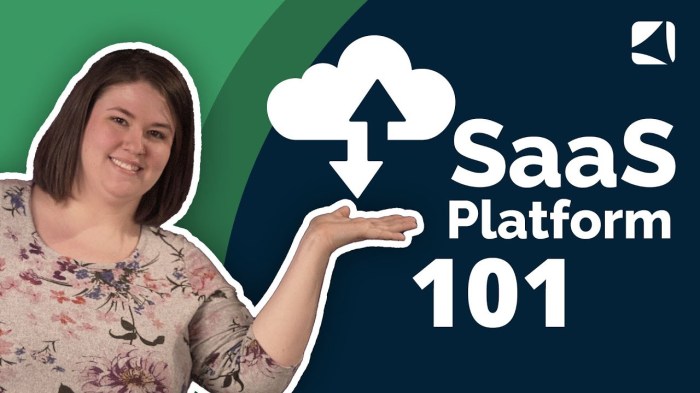With software as a service (SaaS) taking center stage in today’s digital landscape, it signifies a monumental shift in how businesses operate and deliver services. This innovative model allows companies to access and use software over the internet, eliminating the need for traditional installation and management. As we explore the evolution of SaaS from conventional software models, its defining characteristics reveal why it has become a cornerstone of modern technology.
SaaS not only offers remarkable cost efficiency and scalability but also enhances accessibility for users across various industries. With its widespread adoption, we can see how SaaS applications are revolutionizing collaboration among teams, making it easier to work together regardless of location.
Overview of Software as a Service (SaaS)

Software as a Service (SaaS) represents a revolutionary shift in the way software is delivered and consumed. By providing software applications over the internet, SaaS eliminates the need for traditional software installation and management, making it a cornerstone of modern technology solutions.
SaaS has evolved significantly from traditional software models, which often required substantial upfront investments and on-premises deployment. This evolution has been fueled by advancements in cloud computing, which allow for remote access and management of applications, fostering a more agile and user-friendly environment.
Key characteristics that distinguish SaaS from other software delivery models include centralized hosting, subscription-based pricing, automatic updates, and scalability. These features make SaaS an attractive option for businesses seeking cost-effective and flexible software solutions.
Benefits of SaaS

The advantages of adopting SaaS solutions are numerous, significantly impacting businesses and users alike.
- Cost-efficiency: SaaS reduces the need for large upfront software purchases and minimizes ongoing maintenance costs, allowing businesses to allocate resources more effectively.
- Scalability: SaaS applications can easily scale to accommodate growing business needs, providing flexibility in resource allocation.
- Convenience and accessibility: Users can access SaaS applications from any device with an internet connection, enhancing productivity and collaboration.
Common Use Cases for SaaS
SaaS solutions are versatile and applicable across various industries, enhancing operational efficiencies and collaboration.
Examples of industries that benefit from SaaS solutions include:
– Healthcare: Patient management systems and telemedicine platforms.
– Education: Learning management systems and online collaboration tools.
– Finance: Accounting software and financial management tools.
Popular SaaS applications encompass functionalities that cater to diverse business needs:
- Salesforce: Customer relationship management (CRM) software.
- Dropbox: File storage and collaboration platform.
- Slack: Team communication and collaboration tool.
SaaS enhances collaboration by providing teams with real-time access to data and tools, fostering a more integrated work environment.
Challenges and Considerations of SaaS, Software as a service (SaaS)
While SaaS offers many benefits, it also presents certain challenges that businesses must address.
Potential security risks associated with SaaS solutions include data breaches and unauthorized access, necessitating robust security measures.
Compliance with regulatory standards is crucial, particularly for industries that handle sensitive information, requiring businesses to ensure that their SaaS providers adhere to relevant laws.
Limitations businesses may face when adopting SaaS include potential service outages and dependence on internet connectivity, which can disrupt operations if not managed properly.
Comparing SaaS with Other Models
When evaluating software delivery models, it’s essential to understand the key differences between SaaS and other solutions.
SaaS offers distinct advantages over on-premises software, such as lower upfront costs, automatic updates, and reduced maintenance responsibilities. In contrast, on-premises solutions may provide greater control over data but require significant IT resources.
SaaS differs from Platform as a Service (PaaS) and Infrastructure as a Service (IaaS) in its primary focus on delivering complete software applications rather than underlying platforms or infrastructure. PaaS allows developers to build applications on a cloud platform, while IaaS provides virtualized computing resources over the internet.
The Future of SaaS
Emerging trends in SaaS technology indicate a promising future for this delivery model.
Predictions for the growth of SaaS suggest an increasing adoption across various industries, driven by the continuous evolution of cloud technology and user demand for flexibility and efficiency.
The potential impact of artificial intelligence on SaaS development is significant, with AI-driven features enhancing personalization, automation, and decision-making capabilities in SaaS applications.
Implementing a SaaS Solution

Businesses looking to implement a SaaS solution benefit from a structured approach to ensure a successful transition.
A step-by-step guide for implementing SaaS includes identifying business needs, researching potential providers, and evaluating service-level agreements (SLAs).
Key factors to consider during the selection process of a SaaS provider involve assessing scalability, security protocols, and customer support services to ensure alignment with business objectives.
User training and support are vital for successful implementation, enabling teams to maximize the benefits of the chosen SaaS solution and minimize disruptions during the transition.
Case Studies of Successful SaaS Implementations
Many companies have successfully transitioned to SaaS, experiencing transformative results in their operations.
For instance, a global retail chain adopted a SaaS inventory management system, leading to streamlined processes and improved stock accuracy, resulting in reduced operational costs.
Outcomes experienced by these companies often include increased efficiency, enhanced collaboration, and greater scalability to meet evolving business demands.
Lessons learned from these case studies highlight the importance of thorough planning, employee training, and ongoing evaluation to guide future SaaS implementations.
Last Recap
In conclusion, software as a service (SaaS) illustrates a compelling evolution in technology, offering numerous benefits while also presenting unique challenges. As businesses continue to embrace this model, understanding its implications will be crucial for future implementations. By examining successful case studies and emerging trends, organizations can better position themselves for the ongoing growth and integration of SaaS solutions in the years to come.
